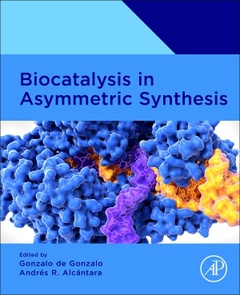Biocatalysis in Asymmetric Synthesis Foundations and Frontiers in Enzymology Series
Coordonnateurs : Gonzalo Gonzalo De, Alcántara Andrés R.

About the editors
Preface
1. Introduction to asymmetric synthesis employing biocatalysts
Andrés R. Alcántara and Gonzalo de Gonzalo
1.1 Introduction
1.2 Type of enzymatic processes for generating asymmetry
1.3 Biocatalysts preparations
1.4 Novel-to-nature enzymatic processes
1.5 Enzymes in multicatalytic systems
1.6 Outlook
References
2. Biocatalysis and Green Chemistry: assessing the greenness of enzymatic processes
Andrés R. Alcántara and Pablo Domínguez de María
2.1 Introduction
2.2 Green Chemistry metrics
2.3 Green Chemistry in biocatalysis for practitioners: defining the boundaries of a biocatalytic reaction
2.4 Conclusions
References
3. Study of stereocontrol in enzymatic reactions using atomic models and computational methods
Daniel Platero-Rochart and Pedro A. Sánchez-Murcia
3.1 Introduction
3.2 Relevant features for stereocontrol in enzymes
3.3 Studying the stereocontrol in enzyme catalysis using atomic models
3.4 Some final considerations for a step-by-step protocol for simulation of enzyme activity
References
4. Control of the activity and enantioselectivity in biocatalyzed procedures: immobilization, medium engineering, and protein engineering
Zhongyao Tang, Fahmi Ihza Alghiffary and Tomoko Matsuda
4.1 Introduction
4.2 Immobilization of enzymes
4.3 Medium engineering
4.4 Protein engineering
4.5 Conclusions and future perspectives
References
5. Hydrolases and their application in asymmetric synthesis
Georgina Sandoval
5.1 Hydrolases
5.2 Low/nonaqueous solvents as media for asymmetric synthesis by hydrolases
5.3 Asymmetric synthesis catalyzed by key lipases
5.4 Proteases (peptidases)
5.5 Other hydrolases in asymmetric synthesis
5.6 Tools to discover and improve hydrolases
5.7 Conclusions
References
6. Biocatalysis for the selective reduction of carbonyl groups
Gonzalo de Gonzalo and Antonio Franconetti
6.1 Introduction
6.2 Examples of the application of alcohol dehydrogenases in asymmetric synthesis
6.3 Dynamic processes catalyzed by alcohol dehydrogenases
6.4 Alcohol dehydrogenases in deracemization protocols
6.5 Use of alcohol dehydrogenases in multienzymatic systems
6.6 Conclusions
References
7. Synthesis of chiral amines employing imine reductases and reductive aminases
Juan Mangas-Sánchez
7.1 Introduction
7.2 Imine reductases: structural and mechanistic aspects
7.3 Cyclic imine reductions
7.4 Imine reductase/RedAm-mediated reductive aminations
7.5 Conclusions and perspectives
References
8. Biocatalyzed CarbonCarbon bond formation in enantioselective synthesis
Daniela Gamenara and Gustavo A. Seoane
8.1 Introduction
8.2 Enzymatic aldol reactions. Enzymes involved. Classification
8.3 Synthetic applications
8.4 Perspectives and concluding remarks
References
9. Synthesis of chiral compounds through biooxidations
Caterina Martin, Hugo L. van Beek, Ivana Maric, Gonzalo de Gonzalo and Nikola Loncar ?
9.1 Introduction
9.2 Dehydrogenases
9.3 Oxidases
9.4 Peroxidases
9.5 Monooxygenases
9.6 Peroxygenases
9.7 Conclusion and perspectives
References
10. Asymmetric biocatalysis in nonconventional media: neat conditions, eutectic solvents, and supercritical conditions
Ningning Zhang and Selin Kara
10.1 Introduction
10.2 Neat conditions
10.3 Eutectic solvents
10.4 Supercritical conditions
10.5 Summary and perspectives
References
11. Multienzyme-catalyzed processes in asymmetric synthesis: state of the art and future trends
Eduardo Macedo de Melo, Christiane Claassen, William Finnigan, Rodrigo O.M.A. de Souza and Dörte Rother
11.1 Introduction
11.2 Process design and optimization
11.3 Recent developments and future trends
11.4 Summary
References
12. Development of asymmetric biotransformations: flow biocatalysis, photobiocatalysis, and microwave biocatalysis
Lucia Tamborini, Francesco Molinari and Andrea Pinto
12.1 Introduction
12.2 Flow biocatalysis
12.3 Photobiocatalysis
12.4 Microwave biocatalysis
12.5 Conclusions
References
13. Industrial asymmetric biocatalysis
Roland Wohlgemuth
13.1 Introduction
13.2 Asymmetric biocatalysis in manufacturing chiral intermediates and building blocks
13.3 Asymmetric biocatalysis in manufacturing chiral pharmaceutical intermediates and active pharmaceutical ingredients
13.4 Biocatalytic synthesis of chiral metabolites
13.5 Biocatalytic synthesis of chiral flavor ingredients
13.6 Biocatalytic synthesis of chiral fragrance ingredients
13.7 Biocatalytic synthesis of chiral cosmetic ingredients
13.8 Biocatalytic synthesis of chiral agrochemicals
13.9 Asymmetric biocatalysis in manufacturing chiral monomers
13.10 Biocatalytic synthesis of chiral oligomers and polymers
13.11 Conclusions
References
14. Patents based on biocatalytic methods for the synthesis of valuable chiral compounds
Nadia Guajardo
14.1 Motivation for the biocatalytic synthesis of chiral compounds
14.2 Methodologies for the synthesis of chiral compound employing wild-type enzymes
14.3 Patented methodologies for the synthesis of chiral compounds employing modified enzymes
14.4 Concluding remarks
References
Index
Prof. Gonzalo de Gonzalo is an Associate Professor at the Organic Chemistry Department of the Chemistry Faculty at the University of Seville, Spain. He obtained his Degree and his Ph.D. in Chemistry at the University of Oviedo, Spain. He spent his postdoctoral stage at Consiglio Nazionale delle Ricerche, Milan, Italy, moving back to University of Oviedo with a Juan de la Cierva Fellowship. In 2010, he spent one year at the University of Groningen, The Netherlands, working in the research of novel oxidative enzymes. He worked two years for the pharmaceutical company Antibióticos S.A.U. León, Spain, moving to Seville in 2014 as a Ramón y Cajal Researcher, getting his present position in 2019. His research is focused on asymmetric synthesis by using different approaches, including biocatalytic and organocatalytic procedures, as well as the development of concurrent chemo- and biocatalytic reactions. He has published more than 90 scientific papers, including two books focused on biocatalysis applied to the synthesis of valuable compounds.
Prof. Andrés R. Alcántara is a Full Professor at the Department of Chemistry in Pharmaceutical Sciences of the Pharmacy Faculty at the Complutense University of Madrid, Spain. He obtained his Degree and his Ph. D. in Chemistry at the University of Córdoba (Spain). He spent his postdoctoral stage at the University of Kent Canterbury (UK), returning to the Complutense University where he was Associate Professor from 1993 until 2018, when he gained Full Professorship. His research has been focused on Biotransformations and Applied Biocatalysis in Organic Chemistry, more specifically, in the preparation of enantiomerically pure compounds as chemical drug precursors, using mainly proteases, lipases and alcohol dehydrogenases, either native or immobilized. On the other hand, his work fits perfectly within Sustainable Chemistry, since he has applied these biocatalysts mainly in sustainable bio-solvents, which generates a very b
- Explores biocatalysts as exquisite catalysts for fine chiral compound synthesis in different reaction media
- Features both foundational overviews and applied, practical examples across research and industry
- Includes chapter contributions from international leaders in the field
Date de parution : 05-2024
Ouvrage de 520 p.
19x23.4 cm



